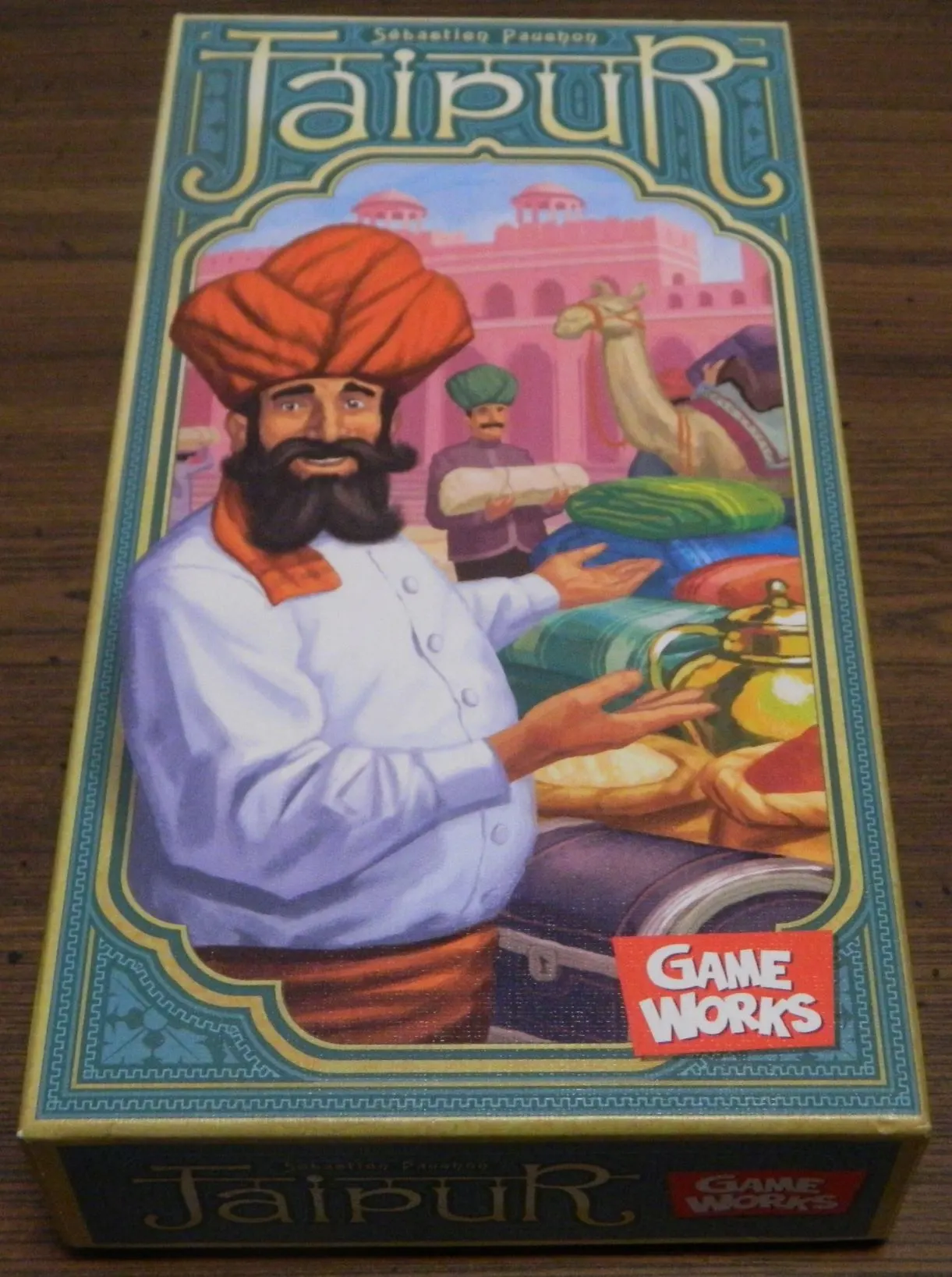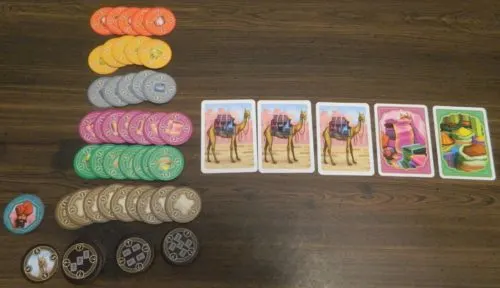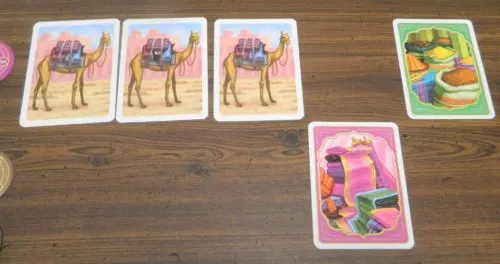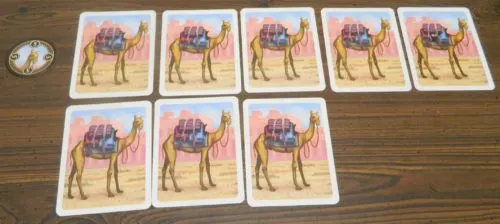One of my favorite board game genres are probably set collecting games.While the concept of collecting cards or other objects of the same color/type is pretty basic, there is a surprising amount you can do with the mechanic. One of the main reasons that I like set collecting games is that they do a good job balancing between being accessible while still providing enough strategy for the players. My personal belief regarding board games is that a good board game never makes itself more complicated than it needs to be. This is a tenant of good set collecting games so I am always on the lookout for a good set collecting game. Today this has brought me to Jaipur which was released ten years ago. While I had never played Jaipur before I was excited to try it out as the game is highly regarded and it seemed like the perfect balance between accessibility and strategy. Jaipur may be a little overrated due to its reliance on luck, but it is still a great game that fans of set collecting games should really enjoy.
How to Play Jaipur
Setup
- Place 3 camel cards face up between the players.
- Shuffle the rest of the cards and deal five to each player.
- Take two cards from the deck and place them face up next to the three camel cards. The rest of the cards form the draw pile.
- The players will look through their cards. Any camel cards that they are dealt are laid out on the table in front of them face up.
- Sort the goods tokens by their type. Lay the tokens out on the table so they can all be seen with the highest valued tokens on top of the lower valued tokens.
- Sort the bonus tokens based on the symbol on the back. Shuffle each type of token separately and place each in their own pile face down.
- Place the camel token and the three Seals of Excellence on the table.
- Choose which player will start the game.
Playing the Game
Jaipur is played over a number of rounds. In Jaipur the players will take turns performing one action before play passes to the other player. On your turn you can take one of two actions.
- Take Cards
- Sell Cards
On your turn you will take one of the two actions, but you can’t perform both actions.
Take Cards
When a player chooses to take cards there are three different ways to take cards. The player can only choose one of the three options.
Take Several Cards
If a player sees several cards that they want from the supply (the five face up cards in the middle of the table) they can take all of the cards they want (they must take at least two). The player can take several different colors of cards, but the player can’t take a camel card. In exchange for these new cards though the player has to replace them with the same number of cards from their hand. For example if a player takes three cards they will have to replace them with three cards from their hand. They can either use goods cards from their hand or camels from in front of them or some combination of both.

This player has decided to take the three purple cards. They will replace the three cards with the three cards on the bottom of the picture.
Players can never have more than seven cards in their hand at the end of their turn. Camel cards do not count towards this total.
Take One Card
If a player only wants one card from the supply they can take the card and add it to their hand. The player cannot use this ability to take a camel card. To replace the card that was taken the top card from the draw pile is turned face up.
Take Camel Cards
Finally a player can choose to take all of the camel cards from the supply. These cards are placed in a face up pile in front of the player. A player does not have to let another player see how many camel cards they have until the end of the round. The camel cards that were taken from the supply are replaced with cards from the draw pile.
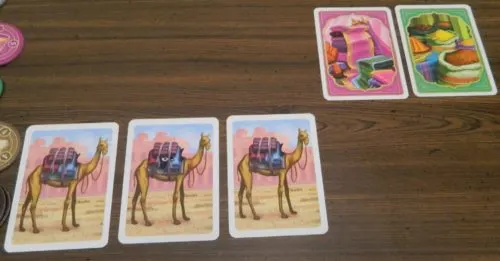
This player has decided to take the three camel cards. These three cards will be replaced with cards from the draw pile.
Sell Cards
If a player wants to sell cards they choose which type of good that they would like to sell. The player can only sell goods of one type each turn. To begin the selling process the player chooses how many cards of the chosen good they would like to sell. The player can sell as many cards of a good that they want, but they must sell at least two cards if they are selling diamonds, gold or silver. The chosen goods cards are added to the discard pile. The player will then take the corresponding number of tokens of the color of cards they sold. They will take the highest valued tokens remaining. If there are not enough tokens for the number of cards that a player has sold, the player loses out on the extra tokens they are owed.
Depending on how many cards a player sold they may be eligible for a bonus token. If a player sells three cards they will take one of the three tokens which range from 1-3 points. When four cards are sold the player will take a four bonus token which is worth between 4-6 points. Finally if a player sells five or more cards of the same color they will receive a five bonus token which is worth between 8-10 points.

This player has sold four purple cards. They took the four highest valued purple tokens remaining. They also got to take a four bonus token as they sold four cards.
End of Round
A round can end in one of two ways.
- All of the tokens from three of the goods have been taken.
- There are not enough cards in the draw pile to replace the missing cards from the supply.
Before counting up points the players will compare how many camel cards they have in front of them. Whichever player has more camel cards will take the camel token. If both players have the same number of camels neither player takes the camel token.
Players will then count up how many points they scored. The player who scored the most points will win a Seal of Excellence. If the players have scored the same number of points, the player who acquired the most bonus tokens will win. If there is still a tie the player with the most goods tokens will win.
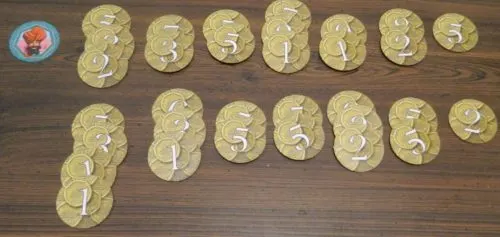
The top player acquired 65 points in the round while the bottom player only acquired 62. Since the top player acquired more points they have won the round and receive the seal of excellence.
If neither player has two Seals of Excellence another round is played. The game is reset following the setup process above. The player who lost the previous round will get to start the next round.
End of Game
The game ends when one of the players acquires their second Seal of Excellence. This player has won the game.
My Thoughts on Jaipur
Jaipur does nothing to try to hide what type of game that it is. It is first and foremost a set collecting game. The objective of the game is to acquire cards of the same suit/color. Once you have acquired enough cards of the same color you can then sell them for tokens which will act as victory points at the end of the round. Anyone that has ever played a set collecting game before should already be quite familiar with these mechanics. The overall framework of the game may be similar to most set collecting games, but Jaipur has some interesting twists to how you acquire and sell cards.
Lets begin with acquiring cards. Instead of just drawing cards Jaipur gives you three different ways to acquire cards. One option is just to take one of the face up cards from the table and add it to your hand. The other two ways of acquiring cards are quite a bit more interesting. Instead of just taking one card from the market you have the option of taking as many cards as you want. If there are several cards that you want you can take all of them on one turn which makes it easier to collect sets. The catch is that you have to exchange the cards you take with cards from your hand. Thus you can change the composition of your hand but you can’t actually change how many cards that you have in your hand. Between these two decisions you have to decide between expanding the number of cards in your hand versus being able to take several cards that you want in one turn.
Things become even more interesting when you add in the third mechanic which is the camel cards. The camel cards are quite interesting as you can’t directly score any points from them. The player that has the most of them at the end of the round will receive a bonus token that is worth five points. Otherwise the camel cards are mostly used in order to manipulate the market. The third way to acquire cards it to take all of the camel cards from the market. The camels can’t be sold but they have use on future turns as you can exchange them for other cards in the market. After selling a large set of cards you can use your camel cards to quickly restock your hand with new cards. They can also be used to take several cards from the market on a turn without having to give up other goods cards from your hand. The camel cards can give you a lot of flexibility in the game.
How you acquire cards and manipulate the market plays a large role in how well you will do in the game. Obviously you want to collect valuable goods cards as well as create large sets in your hand. Sometimes it is just as important to deny your opponent good options. Each time you take cards you are potentially making a move that will help your opponent. When you take a single card or all of the camel cards you are putting new cards into the market for the other player to take. Even swapping cards could help your opponent as you could put out cards they need for one of their sets. Whenever you make a move you need to consider how it is going to benefit your opponent. Sometimes it might make sense to make a move that might not help you very much if you can hurt your opponent in the process. For example you could fill the entire market with camel cards. This then forces the other player to either sell cards or take all of the camel cards. If they take the camel cards you will get a whole new market of cards to choose from which you can take the best cards from before the other player even gets a chance at them. This is a really interesting mechanic as it is sometimes better to play defensively than offensively.
After acquiring the cards you have to figure out what you want to do with them. The goods cards are basically acquired so they can be sold for tokens which are worth points at the end of the round. The selling mechanic is pretty basic on the surface. You sell cards of one type and take the corresponding number of tokens. If you sell enough cards at the same time you will receive a bonus token. Where the selling mechanic becomes interesting is that you have a couple different things to consider when selling cards.
The biggest decision is determining how big of sets that you want to sell. In theory you want to acquire five or more of the same set as you can then get more tokens as well as a more valuable bonus token. You also have to consider the available tokens though. The tokens are arranged where the most valuable for each type are the first tokens taken. Therefore the faster you sell goods of a type the higher the likelihood that you will get the most valuable tokens. There is a benefit to collecting more cards of a type, but you don’t want to take too much time or your opponent could slide in and take the most valuable tokens for that good. This makes the selling mechanic really interesting as you try to read the other player to figure out what they plan on doing.
Another element that will ultimately have an impact on this decision is the hand limit. You can only hold seven cards in your hand at any one time. Thus trying to collect five cards of the same type requires you to commit a large portion of your hand to collecting that good. If you are trying to collect five cards of the same type you are not going to have a lot of flexibility in collecting goods of the other types. You will regularly run into the hand limit which forces you to make hard decisions. There will be times where you want to collect five of the same set, but will ultimately decide to sell it in order to open up space in your hand. You can’t clog up your hand with cards for too long waiting for the final card you need as it ends up limiting what else you can do in the game. While I think the game should have increased the hand size by one or two cards, I actually liked the hand limit which is surprising since I am usually not a fan of hand limits. The hand limit in Jaipur forces players to make important decisions instead of just hoarding cards.
I personally think one of the keys to a good board game is keeping it as simple as possible. There really is no need to make a game more complicated than it needs to be. If a mechanic adds more difficulty than enjoyment it should be removed. Jaipur does a really good job in this area. I was honestly surprised by how easy Jaipur was to play. With a recommended age of 12+ I assumed the game wasn’t going to be super difficult, but I thought it would have a few mechanics that would be a little more complicated and thus take some time to fully understand. That is not the case in Jaipur as the mechanics are really straightforward. On your turn you either take cards or sell them. There are some options regarding what cards you take or sell, but there is nothing complicated about the mechanics. You could honestly teach the game to new players within just a couple minutes. I also think you could teach the game to kids a few years younger than the recommended age and they shouldn’t really have any issues with the game.
In addition to the game being quite easy to play it also plays pretty quickly. Your first game may take a little longer as you adjust to the mechanics, but otherwise the game should move pretty quickly. The overall length is ultimately going to come down to whether one player wins the first two rounds or if you have to go to the third round. Each round will generally take you around 10-15 minutes. This will somewhat depend on how long it takes players to make decisions. With a maximum of three rounds most games should take around 20-30 minutes. At this length Jaipur works well as a filler game. If you don’t have a lot of time you can get in a quick game, or with the shorter length you can quickly play a rematch game.
Jaipur is a good game but I do think it is a little overrated. I had a lot of fun with Jaipur and most people should really enjoy it. I don’t know if it is one of the top 100 board games of all time though which is around where it is currently ranked on Board Game Geek. When I think of games that are in the top 100 of all time I think of games that truly revolutionized the board game industry. Jaipur is good but I don’t think it is that good.
Probably the biggest issue with the game is the fact that it can rely on quite a bit of luck at times. The fact that the game utilizes cards meant that it would have some reliance on luck as there is no way to remove all of the luck from a game that relies on drawing cards. Some luck is not a bad thing as it keeps games interesting. With no luck the game would get repetitive pretty quickly as each game would play the same once players formed a strategy. The reliance on luck goes a little too far in Jaipur though.
First luck comes into play due to card draw luck. Outside of the cards that you are dealt at the beginning of the game you don’t directly draw any cards in the game. Instead the card draw luck comes from which cards are revealed in the market when cards are taken from it. Whenever you take cards from the market you always need to take into consideration what cards could be revealed for the other player. You can try to minimize this by making moves that prevent too many cards from being revealed for the next player’s turn. You have no control over what cards will be revealed though. You could have a bunch of low value cards you don’t need revealed for your turn while the other player gets a lot of high value cards or cards they need to create a larger set. There is no way you can fully overcome this luck as the best you can do is try to minimize it. The player that has the best cards revealed before their turns is going to have a pretty big advantage in the game.
The area that might add even more luck to the game though are the bonus tokens. The value of each type of token will fit within a three point range. You would think two points here or there wouldn’t be that big of deal. It becomes an issue in Jaipur though because most rounds will be really close. Usually the winner will only score maybe five more points than their opponents. Thus two points here or there can end up making a pretty big difference in the game. A player that regularly gets the highest values from their bonus tokens is going to have a pretty big advantage in the game. A player could easily acquire more tokens and lose a round because the other player received more points from their bonus tokens. I really don’t see the point for randomizing the points on the bonus tokens. I would have preferred that the values of each type of bonus tokens were the same so players could make their decisions based on known values rather than hoping to randomly draw the most valuable bonus tokens.
The other issue with Jaipur is that the game is not particularly original. Most of the mechanics in Jaipur can be found in other games. The set collecting mechanics are typical of the genre. The only somewhat unique thing is that you aren’t dealt cards and instead take cards from a set of face up cards. Giving you three different ways of taking cards is kind of unique even though there have been similar mechanics in other games. The selling aspect of the game is also pretty typical of the genre as collecting more cards of a set always gives you a greater benefit as that is what the whole genre is built around. Adding in the element that you take tokens based on how many cards you sell though adds some expediency to the game as you need to choose between trying for a more valuable bonus token or taking the more valuable goods tokens before the other player takes them. The one mechanic that I actually think is pretty unique about Jaipur is the camel cards. There is probably something similar in another set collecting game, but I haven’t played a game that has utilized a similar mechanic. Jaipur may not be a highly original game, but it does a good job packaging the mechanics together to create a truly satisfying experience.
Should You Buy Jaipur?
Being rated as close to one of the top 100 board games of all time as well as being a set collecting game made me really interested in checking out Jaipur. While Jaipur is a little overrated, I thought it was a good game that I had a lot of fun with. At its core Jaipur may seem like your typical set collecting game as it does share a lot in common with your typical game from the genre. The game has some interesting twists on the formula though. You are given three different ways of collecting cards with each having their own positives and negatives. The selling mechanics are also interesting as you want to create large sets to sell, but timing is important due to the hand limit and the fact that you want to sell a good before your opponent does. While Jaipur has a few mechanics the game is surprisingly easy to play and plays quickly. Despite being easy to play there is still quite a bit of strategy to the game. Jaipur does rely on some luck though as what cards are revealed to players and what bonus tokens players draw will have an impact on the outcome.
Jaipur is not a perfect game, but I really enjoyed my time with it. If you either don’t like set collecting or two player games, Jaipur probably won’t be for you. People that are looking for a good two player set collecting game though should really enjoy their time with Jaipur. I would suggest that they consider picking up Jaipur.
Buy Jaipur online: Amazon (Older Version), Amazon (Newer Version)
, eBay

